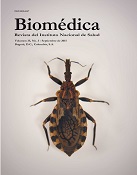Reliability of a questionnaire for measuring physical activity and sedentary behavior in children from preschool to fourth grade
Abstract
Introduction: International recommendations for physical activity and time spent in sedentary behaviors for children in their early years require the availability of measuring instruments with psychometric properties that allow for the assessment of population dynamics and interventions to improve health.
Objective: To evaluate the reliability of a questionnaire to measure physical activity and sedentary behaviors in children from preschool to fourth grade.
Materials and methods: One hundred and eight parents answered the questionnaire. The instrument included socio-demographic variables, as well as those associated with physical activity, including time walking to school, organized sports and playtime activities. Sedentary behaviors included motorized transport to school, reading and “screen time”, sleeping and extracurricular courses. Internal consistency, reproducibility and agreement were evaluated using Cronbach’s alpha coefficient, the Intraclass Correlation Coefficient (ICC) and the Bland and Altman limits of agreement method, respectively.
Results: Internal consistency for physical activity ranged from 0.59 to 0.64, and for sedentary behaviors between 0.22 and 0.34. The highest reproducibility was found for walking to school and time spent on this (kappa=0.79, ICC 0.69), and organized sports, and time on this activity (kappa=0.72, ICC 0.76). Among sedentary behaviors, motorized transport to school and computer use showed kappas of 0.82 and 0.71, respectively; additionally, the time spent on these behaviors showed an ICC of 0.8 and 0.59, respectively. We found limits of agreement between moderate and good for reading time, napping, extracurricular courses, computer and console use.
Conclusion: The questionnaire provided reliable information on the physical activity and sedentary behaviors in children under 10 years of age and could be used in other Latin American countries.
Downloads
Some similar items:
- Maylen Liseth Rojas, Juliana Sánchez, Oscar Villada, Liliana Montoya, Alejandro Díaz, Cristian Vargas, Javier Chica, Ana Milena Herrera, Effectiveness of iron amino acid chelate versus ferrous sulfate as part of a food complement in preschool children with iron deficiency, Medellín, 2011 , Biomedica: Vol. 33 No. 3 (2013)
- Astrid Berena Herrera, Laura A. Rodríguez, Jürg Niederbacher, Biological pollution and its relationship with respiratory symptoms indicative of asthma, Bucaramanga, Colombia , Biomedica: Vol. 31 No. 3 (2011)
- Elpidia Poveda, Diana Giraldo, Yibby Forero, Carlos Mendivil, Self-reported physical activity in comparison with anthropometric body fat indicators in school children , Biomedica: Vol. 28 No. 3 (2008)
- Ligia Inés Moncada, Sandra Milena Rios, Julián Alfredo Fernández, Fabio Rivas, María Luz Sáenz, Pediculosis prevalence and associated risk factors in a nursery school, Bogotá, Colombia , Biomedica: Vol. 28 No. 2 (2008)
- Iván Rodríguez-Núñez, Carlos Manterola, Initial validation of the scale of perceived exertion (EPInfant) in Chilean children , Biomedica: Vol. 36 No. 1 (2016)
- Berta Nelly Restrepo, María Teresa Restrepo, Juan Camilo Beltrán, Mónica Rodríguez, Ruth Emilia Ramírez, Nutritional status of indigenous children aged up to six years in the Embera-Katio Indian , Biomedica: Vol. 26 No. 4 (2006)
- Laura Andrea Rodríguez, Juan José Rey, Astrid Berena Herrera, Henry Castro, Jurg Niederbacher, Lina María Vera, Luz Libia Cala, Fabio Bolívar, Respiratory symptoms associated with asthma prevalence and air pollution in preschool children , Biomedica: Vol. 30 No. 1 (2010)
- Nelsy Loango, Martha Lucía Gallego, Beatriz Restrepo, Patricia Landázuri, Gender, age and plasma lipids differences associated with apolipoprotein E polymorphism in school children , Biomedica: Vol. 29 No. 3 (2009)
- Alejandro Padilla-Guzmán, Olga L. Prado, David Ballesteros, Viviana Rivera, Yessica Bravo, Luisa Murillo , Sandra Narváez, Jessica M. Forero, A hospital management algorithm for acute poisoning by Paraquat® in a pediatric population, a series of cases , Biomedica: Vol. 44 No. 1 (2024)
- Andrés Leonardo González, Ruth Aralí Martínez, Luis Ángel Villar, Clinical evolution of dengue in hospitalized patients , Biomedica: Vol. 28 No. 4 (2008)
| Article metrics | |
|---|---|
| Abstract views | |
| Galley vies | |
| PDF Views | |
| HTML views | |
| Other views | |


























